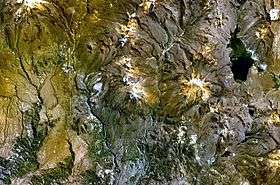Yucamane
| Yucamane | |
|---|---|
| Yucamani | |
 Yucamane (center) and Lake Vilacota (on the right) as seen from above (NASA Landsat7 image) | |
| Highest point | |
| Elevation | 5,550 m (18,210 ft) [1] |
| Coordinates | 17°11′0″S 70°12′0″W / 17.18333°S 70.20000°WCoordinates: 17°11′0″S 70°12′0″W / 17.18333°S 70.20000°W [1] |
| Geography | |
 Yucamane Peru | |
| Location | Peru, Tacna Region |
| Geology | |
| Mountain type | Stratovolcanoes |
| Last eruption | June to November 1902 |
Yucamane[1][2][3][4] or Yucamani[5][6] is an andesitic stratovolcano group in southern Peru.[1] It is located in the Tacna Region, Candarave Province, Candarave District,[5][7] west of lake Wilaquta.[7]
The group is mostly Holocene in age. During the Holocene, Yucamane has shown signs of Plinian eruptions which produced pyroclastic flows. The most recent of these events occurred around 1320 BC.
Morphology
Yucamane is made up of two stratovolcanoes, Yucamane itself which rises to 5,550 m above sea level and Calientes which rises to 5,358 m above sea level. Only Yucamane has a youthful summit crater.
Eruptions
The only recorded activity was an eruption of uncertain specification in 1787. Eruptions were reported in the 19th and 20th centuries, but these are considered unlikely.
See also
References
- 1 2 3 4 "Yucamane". Global Volcanism Program. Smithsonian Institution. Retrieved 5 January 2012.
- ↑ "Volcán Yucamane". ovi.ingemmet.gob.pe (in Spanish). INGEMMET. Retrieved 2016-08-01.
- ↑ "Yucamane". www.volcanodiscovery.com. Retrieved 2016-08-01.
- ↑ Rivera, Marco; Mariño, Jersy (2004). "Volcán Yucamane (sur del Peru): Geología, Petrología y evaluación preliminar de las amenazas volcánicas". Boletín de la Sociedad Geológica del Perú (in Spanish). 98: 7–27.
- 1 2 "Datos Generales | Candarave". www.candarave.gob.pe (in Spanish). Retrieved 2016-08-01.
- ↑ "Volcán Yucamani". Inventario Turistico del Perú (in Spanish). MINCETUR. Retrieved 2016-08-01.
- 1 2 escale.minedu.gob.pe - UGEL map of the Candarave Province (Tacna Region)